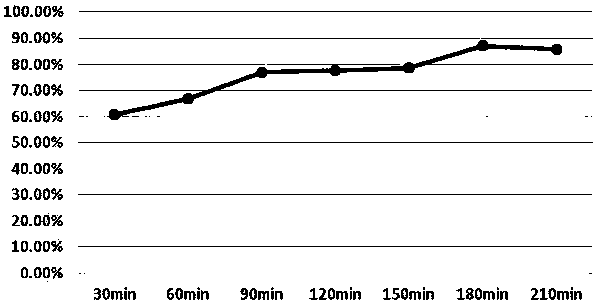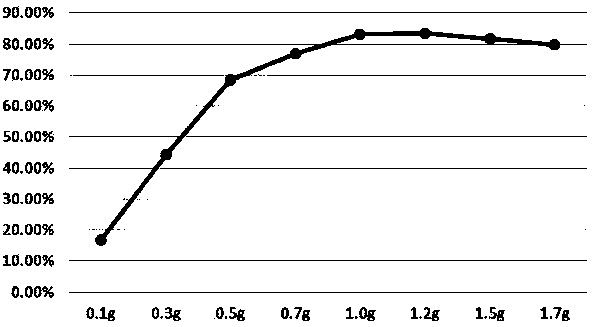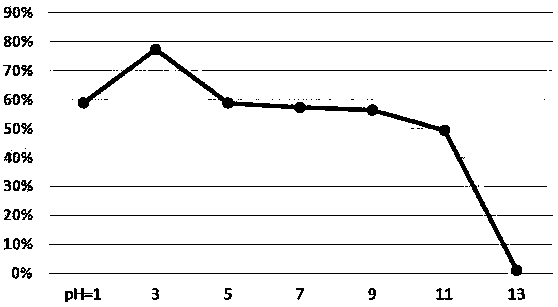Method for treating printing and dyeing wastewater by using leaves as adsorbent
A printing and dyeing wastewater and adsorbent technology, applied in the direction of adsorption water/sewage treatment, water/sewage treatment, chemical instruments and methods, etc., can solve problems such as difficult, not a good treatment method, expensive, etc., to reduce the environmental impact Destruction, good research and development prospects, low cost effects
Pending Publication Date: 2020-06-30
WENHUA UNIV
View PDF0 Cites 0 Cited by
- Summary
- Abstract
- Description
- Claims
- Application Information
AI Technical Summary
Problems solved by technology
Dye wastewater has a large chroma, complex water quality components, high COD, BOD content, high organic content, and heavy metals. It is the key to remediate wastewater, and it is expensive and difficult to treat.
Today, there are three major treatment methods: physical method, chemical method, and biological method. The activated carbon adsorption effect in the physical method is good, but it is not a renewable resource and is expensive. It is not a good treatment method for high-yield printing and dyeing wastewater. There are many chemical methods. There is secondary pollution, the microorganisms in the biological method have high requirements for the living environment, and the economic benefits are low
Method used
the structure of the environmentally friendly knitted fabric provided by the present invention; figure 2 Flow chart of the yarn wrapping machine for environmentally friendly knitted fabrics and storage devices; image 3 Is the parameter map of the yarn covering machine
View moreImage
Smart Image Click on the blue labels to locate them in the text.
Smart ImageViewing Examples
Examples
Experimental program
Comparison scheme
Effect test
Embodiment Construction
[0021] In order to make the content of the present invention more easily and clearly understood, the following further describes the present invention in detail based on specific embodiments in conjunction with the accompanying drawings.
[0022] The embodiment of the present invention adopts a laboratory simulation method for processing industrial printing and dyeing wastewater to implement the technical scheme of the present invention.
the structure of the environmentally friendly knitted fabric provided by the present invention; figure 2 Flow chart of the yarn wrapping machine for environmentally friendly knitted fabrics and storage devices; image 3 Is the parameter map of the yarn covering machine
Login to View More PUM
 Login to View More
Login to View More Abstract
The invention provides a method for treating printing and dyeing wastewater by using leaves as an adsorbent. The method mainly comprises the following steps: by taking phoenix tree leaves as a leaf-based adsorbent, crushing the cleaned phoenix tree leaves by using a crusher to form leaf powder, and filtering and screening the leaf powder by using a 60-mesh sieve; adding 0.7-1.7 g of the leaf powder into every 50 mL of the wastewater solution according to a ratio to form a mixed solution, adjusting the pH value of the mixed solution to 2.5-3.5, and fully stirring by using a magnetic stirrer; then filtering the mixed solution, and drying obtained filtered residues by adopting baking equipment to form colored leaf-based powder; taking a coating matrix, and adding 2-4g of colored leaf-based powder into every 50g of the coating matrix according to the proportion. The method provided by the invention is low in cost, can effectively decolorize the industrial printing and dyeing wastewater andremove harmful substances, can recycle resources, does not cause secondary pollution, and reduces the damage to the environment.
Description
Technical field [0001] The present invention relates to the technical field of industrial wastewater treatment, and in particular to a method for treating printing and dyeing wastewater using leaves as an adsorbent. Background technique [0002] Leaves, especially dead leaves, are a natural product that can be seen everywhere in cities and rural areas and has a wide range of sources. The treatment methods at home and abroad are mostly burning or stacking. The burning treatment is only for reducing the air quality. There are serious impacts; while stacking will occupy a large area and affect the appearance of the city; as a land fertilizer, it will slowly decompose and have a low utilization rate; if it can be used as a raw material as a natural adsorbent to treat the printing and dyeing wastewater, the leaf waste will be treated Harmful treatment has not only become an excellent way to treat wastewater, but also can improve the efficiency of leaf waste treatment, and leaf raw mat...
Claims
the structure of the environmentally friendly knitted fabric provided by the present invention; figure 2 Flow chart of the yarn wrapping machine for environmentally friendly knitted fabrics and storage devices; image 3 Is the parameter map of the yarn covering machine
Login to View More Application Information
Patent Timeline
 Login to View More
Login to View More IPC IPC(8): C02F1/28C02F101/30
CPCC02F1/286C02F2101/308
Inventor 李芳芳张芳罗艺涓邓仕棋龙昊宇
Owner WENHUA UNIV
Features
- R&D
- Intellectual Property
- Life Sciences
- Materials
- Tech Scout
Why Patsnap Eureka
- Unparalleled Data Quality
- Higher Quality Content
- 60% Fewer Hallucinations
Social media
Patsnap Eureka Blog
Learn More Browse by: Latest US Patents, China's latest patents, Technical Efficacy Thesaurus, Application Domain, Technology Topic, Popular Technical Reports.
© 2025 PatSnap. All rights reserved.Legal|Privacy policy|Modern Slavery Act Transparency Statement|Sitemap|About US| Contact US: help@patsnap.com



